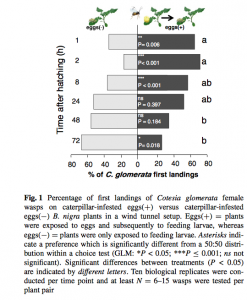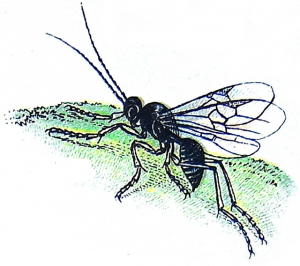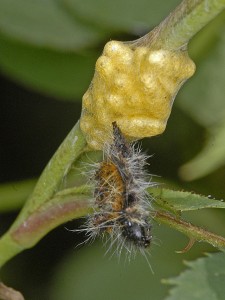In order to successfully find food or prey, animals must use the information that they receive from their environment. One such signal animals could receive comes from plants. Volatile organic compounds are released by plants and have an effect on some animals’ abilities to locate food, prey, or hosts. Wasps are one example of an animal that uses plant volatiles induced by herbivore activities such as feeding and egg-laying to hunt for hosts.
Cotesia glomerata are parasitoid wasps, which means that they are parasites that most likely harm their hosts. Parasitoids are thought to be attracted to volatiles. Pashalidou et al. (2015) compared the attraction of these wasps to the volatiles given off of black mustard plants. The plants were induced with both eggs and larval stages of a butterfly or induced only by larval feeding in a wind tunnel. Pashalidou et al. (2015) hypothesized that changes in the wasp parasitoid preference are based on herbivore plant volatile signals. The volatile signals are thought to influence the wasp to pick the more suitable host.
Pashalidou et al. (2015) found that female wasps significantly preferred plants with eggs rather than clean plants. Female wasps preferred volatile blends given off by plants that were being fed on by caterpillars and infested with eggs over volatiles given off by plants that were only being fed on by caterpillars (See Figure 1 below). Volatile analysis of the 39 detected signals revealed that the volatile blends changed over time. Insects can detect volatile differences based on absence or presence of compounds (species-specific odor recognition), changes in the ratios of the compounds (ratio-specific odor recognition), or perception of the entire blend (whole-blend odor recognition). No significant differences were found in this study among these categories.
Volatile analysis of the 39 detected signals revealed that the volatile blends changed over time. Insects can detect volatile differences based on absence or presence of compounds (species-specific odor recognition), changes in the ratios of the compounds (ratio-specific odor recognition), or perception of the entire blend (whole-blend odor recognition). No significant differences were found in this study among these categories.
The results found that caterpillars’ egg laying influences herbivore stimulated plant volatiles. The volatile changes occurred in response to caterpillar feeding and parasitoid interactions. Pashalidou et al. (2015) showed that wasps are attracted to plants that are infested with eggs, but did not exactly confirm his hypothesis that that changes in the wasp parasitoid preference were based on herbivore plant volatile signals. He proved that there is a relationship between them, but there is no definitive evidence saying the volatile signals specifically caused wasp parasitoid preference. Even though no differences were found among individual volatile emissions, based off of the data this study does support ratio-specific odor recognition.
Finding a host is directly linked to the production of offspring in parasitic wasps. It is important for wasps to find their hosts quickly since the wasps have to face egg-induced plant defenses and the immune defenses of the caterpillar. In order to find suitable hosts, wasps must use their olfactory or chemosensory system to detect the volatile signals from plants. Without these systems, it could be more difficult or maybe even impossible for wasps to determine suitable hosts.
Reference: Pashalidou, F. G., Gols, R., Berkhout, B. W., Weldegergis, B. T., Van Loon, J. J. A. (2015). To be in time: egg deposition enhances plant-mediated detection of young caterpillers by parasitoids. Oecologia.


